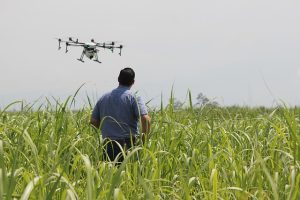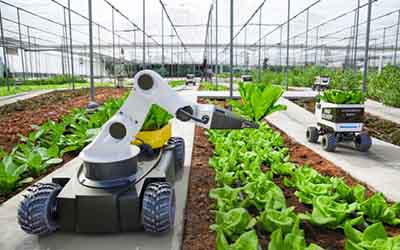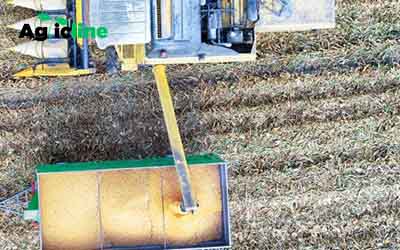There are different precision agriculture technologies everyone ought to know. Precision agriculture can be defined as a farming management concept based on observing, measuring, and responding to inter- and intra-field variability in crops.
It’s all about doing the right thing, in the right place, at the right time – a maxim that epitomizes efficiency. Using a plethora of technologies, ranging from drones to data analytics, it empowers farmers to micromanage their fields for better yield, reduced wastage, and enhanced sustainability.
But why does this shift towards technological infusion matter in agriculture? The reasons are manifold. Firstly, as global food demand skyrockets, it’s imperative to get more from every acre without straining our planet’s limited resources.
Precision agriculture offers a promising solution to this challenge, ensuring that each section of a farm receives just the right amount of inputs, thereby optimizing productivity.
Introduction to precision agriculture technologies
Long before the dawn of modern technology, agriculture has been the bedrock upon which civilizations flourished.
The journey from the rudimentary stick plows of ancient times to the tech-infused machinery of today is both fascinating and reflective of humanity’s ingenuity.
Agriculture began approximately 10,000 years ago when nomadic tribes settled and began to cultivate plants and domesticate animals. Simple tools, primarily made of stone and wood, aided in tasks like plowing and harvesting.
With the advent of iron tools, farming underwent significant changes. The heavy plough was a notable innovation, allowing for deeper soil cultivation. This period also saw the establishment of three-field crop rotation, increasing productivity and soil health.
The 18th and 19th centuries heralded the mechanization of farming. From the cotton gin to the steam-powered tractor, these innovations reduced manual labor and increased crop output manifold.
Post-World War II, the ‘Green Revolution’ took center stage, characterized by the use of synthetic fertilizers, pesticides, and high-yield crop varieties. While this dramatically boosted global food production, it also raised concerns about sustainability and environmental impact.
As we approached the close of the 20th century, it became evident that a more sustainable and precise approach to farming was needed.
The seeds for precision agriculture were sown in the 1980s, guided by the principle that variability exists within fields and that this variability could be managed more effectively with the help of technology.
Benefits of precision agriculture
See below;
Addressing the Surge in Global Food Demand
Our world is experiencing a population boom, with estimates suggesting that we could be nearing 10 billion people by 2050.
This exponential growth translates into a formidable challenge: how to feed an ever-growing population with finite agricultural resources? Traditional farming methods, while foundational, often lack the efficiency required to meet this escalating demand.
- Limited Arable Land
As urbanization sprawls, arable land becomes scarcer. Precision agriculture maximizes the yield from every available acre, ensuring we get more from less.
- Efficiency in Resource Utilization
Through precise monitoring and application of inputs like water, seeds, and fertilizers, waste is minimized, and yield is optimized, catering to the increasing food demands.
Battling the Impacts of Climate Change
The specter of climate change casts a long shadow over modern agriculture. Unpredictable weather patterns, ranging from prolonged droughts to unexpected frosts, make traditional farming a gamble.
- Adaptive Farming
With sensor technologies and real-time data analysis, precision agriculture allows farmers to adapt swiftly to changing environmental conditions. For instance, irrigation can be adjusted based on real-time soil moisture data.
- Mitigating Risks
By closely monitoring fields using technologies like drones and remote sensing, farmers can detect early signs of crop stress or disease, enabling timely interventions.
Championing Sustainable Farming Practices
Beyond just productivity, there’s a growing consensus on the importance of sustainable and eco-friendly farming.
- Reduced Environmental Footprint
Precision agriculture promotes the judicious use of inputs. By applying fertilizers and pesticides only where needed and in exact amounts, we reduce runoff into waterways and decrease the environmental impact.
- Conservation of Resources
Technologies like Variable Rate Technology (VRT) ensure that water, seeds, and other inputs are used optimally, leading to conservation of these crucial resources.
- Enhancing Soil Health
Precision techniques often include soil health monitoring. By understanding the soil’s needs and addressing nutrient deficiencies with precision, we can maintain and even improve soil health over time, ensuring its viability for future generations.
Precision agriculture technology examples; Core Technologies Driving Precision Agriculture
See below;
Remote Sensing Technology
Harnessing the power of advanced optics and data processing, remote sensing technologies have transformed the landscape of modern agriculture.
Satellite and Drone-based Imagery
While satellites provide a broad and frequent overview of large farmlands, drones give a closer, more detailed look, allowing for high-resolution imagery of fields.
- Applications
From assessing plant health using multispectral imaging to monitoring the growth stages, these aerial platforms are invaluable in gauging a field’s condition from above.
Benefits
-
- Soil Health Analysis: Remote sensing can identify areas of soil compaction, moisture levels, and nutrient deficiencies.
- Disease Detection: Early signs of plant diseases, often undetectable to the naked eye, can be spotted, enabling timely interventions.
- Crop Monitoring: Regular monitoring allows farmers to track crop growth, identify potential issues, and make informed decisions.
GPS & GIS Systems
The backbone of precision agriculture, these systems provide the spatial accuracy that modern farming demands.
Role
- Precise Planting: GPS systems guide machinery, ensuring seeds are planted at optimal locations and depths.
- Tracking and Mapping: They allow for the creation of detailed farm maps, highlighting different zones based on soil health, moisture, and other parameters.
Benefits
-
- Efficient Use of Resources: By knowing exactly where to act, farmers can apply inputs like water and fertilizers more judiciously.
- Yield Maximization: Accurate planting and tracking lead to better growth conditions and, subsequently, enhanced yields.
Variable Rate Technology (VRT)
This technology epitomizes the “right amount at the right place” philosophy.
Functionality
- VRT systems adjust the rate of input application in real-time based on the specific needs of different zones within a field.
Benefits
-
- Optimal Utilization: Ensures that no section is over or under-fertilized, leading to uniform crop growth.
- Reduced Wastage: Inputs are applied only where required.
- Environmental Sustainability: Minimized over-application reduces runoff, protecting local ecosystems.

Automated Machinery & Robotics
Automation, a buzzword in various industries, finds its place in modern agriculture too.
Innovations
- Driverless Tractors: Programmed to till, sow, and even harvest, these machines can operate round the clock.
- Robotic Harvesters and Drones: Specialized robots for tasks like fruit picking, coupled with drones for aerial tasks, reduce manual labor.
Benefits
-
- Labor Efficiency: Automated machines can handle repetitive tasks, freeing up human labor for more intricate tasks.
- Precision Tasks: Robots, with their accuracy, ensure tasks are performed with minimal error.
- 24/7 Operations: Many automated systems can function day and night, ensuring timely operations.
Internet of Things (IoT) in Agriculture
A network of interconnected devices, IoT brings a new dimension to real-time monitoring.
Functionality
-
- Sensor-based Technologies: These sensors, strategically placed, can relay information about soil moisture, weather conditions, and crop health directly to the farmer’s devices.
Benefits
-
- Instant Decision-making: Real-time data enables farmers to make immediate adjustments, from irrigation to pest control measures.
- Reduced Input Costs: Efficient resource utilization, driven by accurate data, can lead to significant cost savings.
Data Analytics & Farm Management Software
Transforming raw data into actionable insights is at the heart of this technology.
Functionality
- Software platforms that collate data, from soil sensors to drone imagery, analyze it, and present farmers with comprehensive insights about their fields.
Benefits
-
- Improved Yields: By understanding patterns and predictions, farmers can implement best practices tailored to their fields.
- Predictive Analysis: Anticipate potential challenges, from pest invasions to weather impacts.
- Profitability Insights: Analytics can highlight cost-effective practices and areas for investment, driving farm profitability.
The Environmental & Economic Impact of Precision Agriculture
Agriculture, while a cornerstone of human civilization, has traditionally had significant environmental and economic challenges.
With the emergence of precision agriculture, there’s a concerted effort to mitigate these challenges, ushering in a new era of sustainable and profitable farming.
Efficient Water Management
- Micro-irrigation Systems: Leveraging precision technologies, these systems deliver water directly to the plant roots, minimizing evaporation losses.
- Benefits: This not only conserves water but also ensures that plants receive the optimal amount, leading to healthier crops and reduced water bills.
Targeted Use of Pesticides and Fertilizers
- Functionality: By analyzing soil and crop health data, precision agriculture tools can pinpoint areas that require treatments, eliminating the blanket application approach.
- Benefits: Reduced chemical use means lesser pollutants in the ecosystem and decreased input costs for farmers.
Conservation of Soil and Reduction in Carbon Footprint
- No-till & Minimal Tillage Practices: With precision machinery, farmers can opt for practices that minimize soil disturbance. This helps in preserving soil structure, moisture, and organic matter.
- Benefits: Healthier soil leads to increased crop yields and reduced soil erosion, preserving the land for future generations.
Carbon Sequestration & Lower Emissions
- Functionality: Advanced farm machinery, guided by precise data, often operates more efficiently, leading to reduced fuel consumption and greenhouse gas emissions. Additionally, healthier soils have a better capacity to sequester carbon.
- Benefits: These practices contribute to combating climate change and also result in financial savings for farmers in fuel costs.
Increased Yield and Profitability for Farmers
Maximizing Productivity
-
- Functionality: With real-time monitoring and data-driven decisions, every square foot of a farm can be optimized for maximum yield.
- Benefits: Higher yields translate to increased revenue, ensuring that farmers get the most out of their efforts and investments.
Cost Savings & Efficiency:
-
- Functionality: Precise application of resources, whether it’s water, seeds, or fertilizers, means less wastage. Automated machinery reduces labor costs and increases operational efficiency.
- Benefits: Reduced input costs, coupled with increased yields, lead to enhanced profitability. Farmers can reinvest these profits for further technological advancements or diversify their farming practices.
Challenges Faced
- Inconsistent Yields
- Water Scarcity
- Increasing Costs
- Labor Shortages
Conclusion on the precision agriculture technologies
Precision agriculture has emerged as not just a trend but a necessity, offering the tools and techniques to address some of the most pressing concerns of our age.
Agriculture has been the backbone of civilizations for millennia, and today, it faces a momentous period of transformation. The promise of precision agriculture is immense: from the ability to produce more with less, to making farming environmentally friendly, and offering farmers a profitable and sustainable future.
However, the realization of this promise isn’t the responsibility of farmers alone. Tech developers play a crucial role in creating user-friendly, scalable, and effective solutions. Policymakers, on the other hand, hold the key to fostering an environment conducive to the adoption of these innovations through supportive regulations, financial incentives, and infrastructure development.
The future of agriculture, and by extension, our planet, rests on collaboration. It’s time for farmers, technologists, researchers, and policymakers to come together, share knowledge, and co-create the future. A future where farms thrive, ecosystems flourish, and communities prosper.
If you are a farmer, embrace the wave of precision technologies and seek partnerships. If you are a tech developer, listen closely to the needs of the agricultural community and innovate responsively.
Recommendations
Does companion planting tomatoes and basil work?
Does companion planting tomatoes and cucumbers work?
Best farming technology in India



